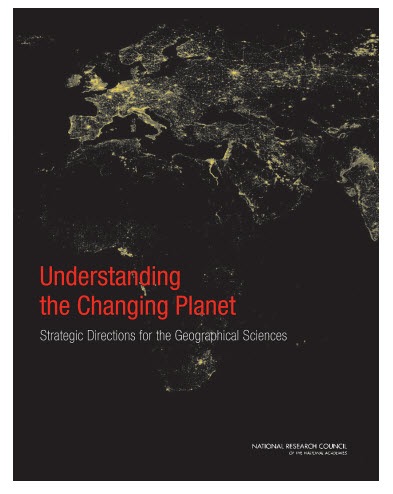The National Research Council (NRC) has created a landmark report entitled Understanding the Changing Planet: Strategic Directions for the Geographical Sciences, which I believe has key implications for GIS education. Under the auspices of the NRC, the project was co-sponsored by the US National Science Foundation, National Geographic Society, the Association of American Geographers, and the US Geological Survey. Particularly insightful readings are Dr Michael Gould’s article about GIScience grand challenges and Dr Dawn Wright’s interview about the NRC report. The charge to the committee of geographers was to formulate a short list of high-priority research questions that are relevant to societal needs. The 11 resulting questions are squarely centered on many of the key issues of the 21st Century. I also believe that they fundamentally support what the GIS education community has been engaged in these past 20 years. The report can be effectively used as a means of communicating why it is vital that GIS education and GIS in education must be supported, nurtured, and strengthened throughout the educational system. But it is up to us, the GIS education community, to make the ties between our work and the NRC report clear and well known.

The 11 questions deemed “high priority” are as follows:
A. How to understand and respond to environmental change:
1. How are we changing the physical environment of Earth’s surface?
2. How can we best preserve biological diversity and protect endangered ecosystems?
3. How are climate and other environmental changes affecting the vulnerabilities of coupled human-environment systems?
B. How to promote sustainability:
4. Where and how will 10 billion people live?
5. How will we sustainably feed everyone in the coming decade and beyond?
6. How does where we live affect our health?
C. How to recognize and cope with the rapid spatial reorganization of economy and society:
7. How is the movement of people, goods, and ideas changing the world?
8. How is economic globalization affecting inequality?
9. How are geopolitical shifts influencing peace and stability?
D. How to leverage technological change for the benefit of society and environment:
10. How might we better observe, analyze, and visualize a changing world?
11. What are the societal implications of citizen mapping and mapping citizens?
Space does not permit me to discuss all of the linkages between this list and GIS education, but I submit that every one of these questions is tied to what and how we teach with GIS. In addition, the very reason GIS was created was to better observe, analyze, and visualize our world (question 10). Modeling, predicting, and managing change over time and space is what GIS enables people to do easily and effectively. Spatial analysis is critical to understanding environmental change, population and resource pressure, geopolitics and trade, and to promoting best practices and sustainable population, habitat, energy, and much more. As this list and report make clear, GIS is more relevant to society as never before.
How might you use the Understanding the Changing Planet report to communicate the importance of your work in GIS education?
- Joseph Kerski, Esri Education Manager



















